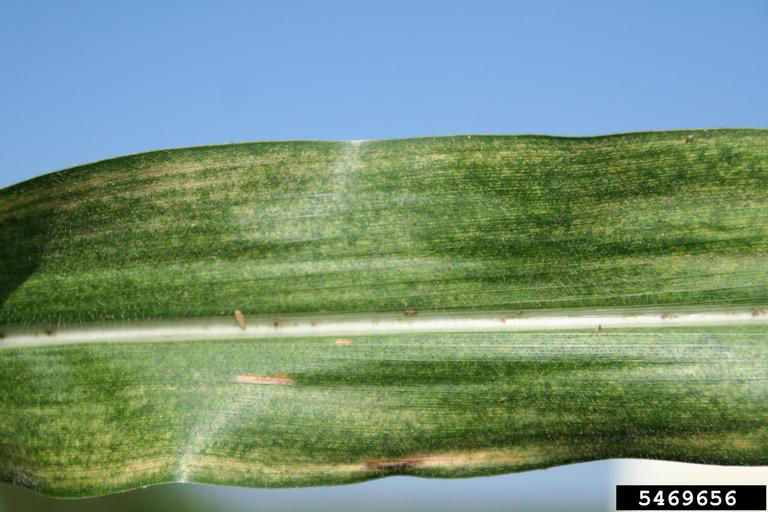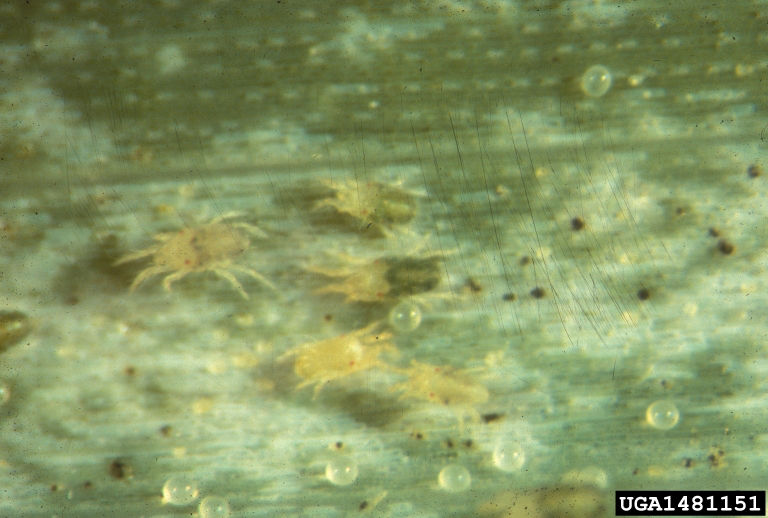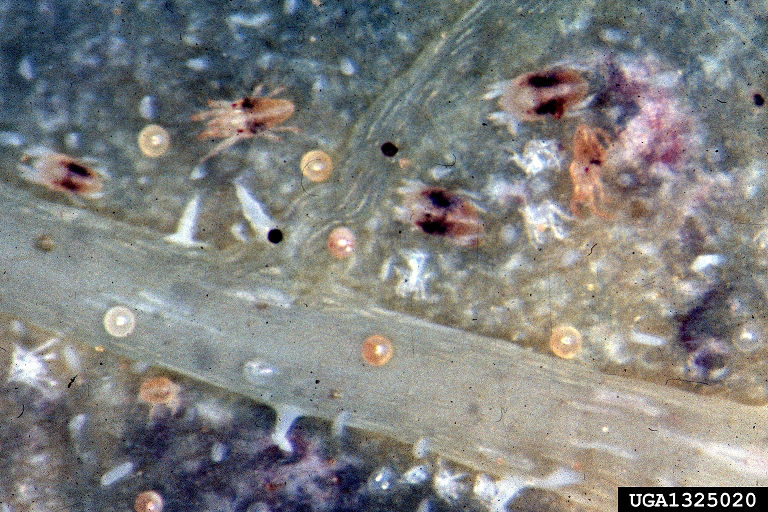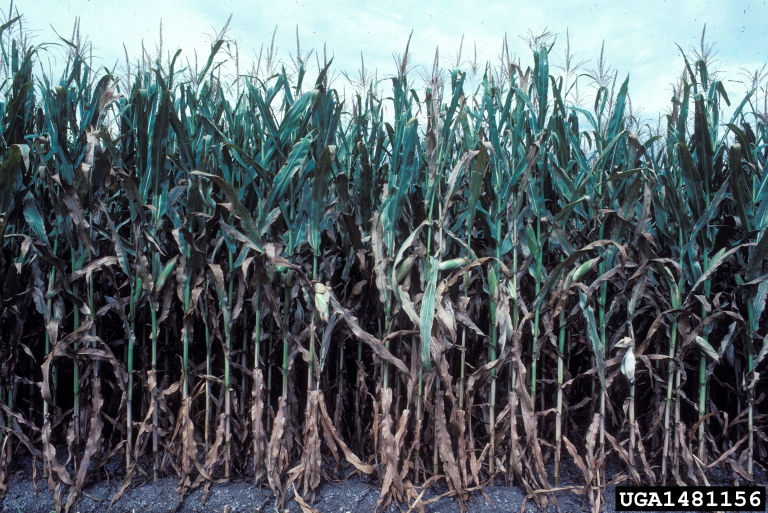5 MIN READ
Managing Spider Mites in Corn
January 10, 2023
Spider mite infestations in corn can be common under hot and dry conditions, particularly on drought-stressed corn. Yellowish or whitish spotting (stippling) on leaves (Figure 1) is evidence of their presence. Banks grass mite (BGM) and two-spotted spider mite (TSSM) are common spider mites found on corn with the TSSM having a broader host range, and the BGM associated with only grasses.

What to Watch For
Spider mites are tiny arachnids (related to ticks and spiders) and distribute in clusters which feed on the underside of corn leaves. The mite feeding results in yellowish or whitish spots across the upper leaf surface. The symptoms are referred to as stippling. Mites use piercing and sucking mouth parts to suck plant juices (sap) that causes the stippling damage. Mites produce fine silken webs on the underside of the corn leaf that can be easily seen under low magnification. Spider mites pass through three immature stages (one larval and two nymph) prior to adulthood. Females lay approximately 20 eggs per day and live for two to four weeks. Large populations can develop quickly in hot and dry weather. Timely rainfall, irrigation, natural enemies, and miticides can help control infestations and protect yield potential. A new generation can be produced every four to twenty days, depending on temperature, and under ideal conditions, populations can increase 70-fold in one generation.1,2 Adult spider mites overwinter in the soil, litter, or weeds within and along corn fields. They disperse by crawling, or by being carried in wind currents.
Banks Grass Mite (BGM), Oligonychus pratensis
Adult males are dark green with a pointed abdomen; females are larger with a more rounded abdomen (Figure 2).
- BGM thrive under hot weather conditions (optimal 96-99 °F/35.5-37 °C).
- Commonly found first near field edges adjacent to other grasses, or next to a maturing small grain field that will be harvested for grain. Spider mites can often be first detected on a south field edge, which is typically the first area in a field to show symptoms of drought due to hot and dry winds.
- The mites climb to the tip of dry grass plants and disperse into the wind on a silken strand and can travel long distances. When landing in neighboring corn fields, they start feeding on the undersides of the lower leaves and migrate to the upper leaves as the lower leaves die or as the corn crop matures.
- Common in corn from mid-whorl through grain-filling growth stages, which is often earlier than when a TSSM is detected in a corn field.
- Commonly found in the western Corn Belt in the U.S. and Alberta and Saskatchewan.
- BGM adults can only overwinter on grass species plants, like overwintering small grain plants.

Two-Spotted Spider Mite (TSSM), Tetranychus urticane
Adults are yellow-green to dull orange with two irregularly shaped dark spots on the abdomen (Figure 3).
- TSSM adults prefer slightly cooler temperatures (optimal 86-90°F/30-32°C) than BGM.
- Move into the field from field margins from host plants, both grass and broadleaf plants.
- Mites are often worse along the field edge next to a dirt road where the corn plants are covered by dust.3
- More common in the humid central and eastern Corn Belt; however, dry conditions allow for populations to increase anywhere including the western Corn Belt.
- Infestations are usually more sporadic within corn fields and are rarely seen on corn plants before flowering.
- The carmine spider mite or red spider mite was once thought to be a separate spider mite species but now is considered a sub-species of the TSSM. Both spider mites are now classified as Tetranychus urticane.
- TSSM can overwinter on both grasses and broadleaf plants but most often overwinter on broadleaf plants like alfalfa.

Impact on the Corn Crop
The injury by the mites, in conjunction with drought stress, increases the stress on the plant and negatively impacts photosynthesis (Figure 4). Early plant injury can result in lost yield potential which can have grain losses ranging from 6 to 48 percent and as high as 40 percent yield loss for corn harvested as silage (dry matter).1

Managing Spider Mites
Water - Proper irrigation and timely rainfall can help reduce the potential for drought-stressed plants and the environment in which mites thrive. Overhead irrigation that drops the spray nozzles into the corn canopy to spray up and onto the underside of the corn leaves and around the ear leaf, can reduce spider mite pressure.
- Drought tolerant corn products – When drought-tolerant corn products are grown under water-stressed environments, often significantly lower Banks grass mite and other spider mite populations are observed than when less drought tolerant corn products are grown under drought stress.
- Beneficial insects - Lady beetles, minute pirate bugs, lacewing larvae, thrips, and predatory mites feed upon BGMs and TSSMs and in doing so, help reduce their threat.
- Fungal diseases - Fungal diseases can have a large impact on mite populations after a rain and under humid conditions, but the fungal pathogens are severely limited during drought conditions.
- Miticides - Consider using a miticide with other insecticides if mites are present and other insects warrant control. If predatory insects are controlled and a miticide is not used, the mite population has the potential to increase rapidly. Closely examine infested leaves prior to treatment. When a reevaluation can be safely made after treatment, examine the leaves again to determine effectiveness. If the treatment was effective, adult mites should have been killed; however, eggs may continue to hatch, and repopulation started.
- Treatment in corn is usually justified when:
- The crop is in the early reproductive stages (R1-R4).
- Extensive colonies of live mites are present throughout the field.
- There is visible leaf damage near the ears.
- There is a good probability of continued drought/heat stress.
- Guidelines in corn for potential chemical control include:
- Treat if damage is visible in the lower third of the plant and mite colonies are present and active in the middle third of the plant (around the ear leaf).
- Treat if active mite colonies are found on one third of the leaves of half of the plants.
- Treat if 15 to 20% of the leaf area is covered with mites and their damage. A pre-tassel preventative treatment may be warranted if the field has a spider mite history, temperatures are expected to exceed 95°F, plants are drought-stressed, the field was previously treated with an insecticide and natural predators were reduced, and mites were found on most of the plants early in the growing season.
- Once the corn has reached the hard dough growth stage no economic benefit will result from a treatment.2
- Resistance to miticides - The potential level of resistance varies with species, location, and year. Although BGM is generally considered to be less miticide resistant than TSSM, both can be highly resistant in areas with long histories of insecticide and miticide use in corn and other crops.2 It is important to use different chemical modes-of-action when choosing a miticide if a second treatment is required or the same field is treated year after year. This is important because spider mites can have 10 to 15 generations per year. Multiple generations, along with applying the same chemical mode-of-action can quickly lead to the development of resistance. Always read and follow the insecticide label with special attention to reentry requirements.
Sources
1 Cullen, E. and Schramm, S. 2009. Two-spotted spider mite management in soybean and corn. University of Wisconsin Extension. A3890. http://corn.agronomy.wisc.edu/.
2 Peairs, F.B. 2014. Spider mites in corn. Colorado State University Extension 5.555. https://extension.colostate.edu/topic-areas/insects/spider-mites-in-corn-5-555/.
3 2009. Two-spotted spider mites. Ministry of Agriculture Food and Rural Affairs. Ontario Crop IPM. http://www.omafra.gov.on.ca/IPM/english/tomatoes/insects/two-spotted-spider-mite.html.
Web sources verified 10/27/22. 1215_58146